From Victory to Victory
Vladimir Barsky’s report about Rounds 5-7 of the Russian Team Championships in Sochi
After seven rounds, the intrigue in the women's championship is practically exhausted: the Moscow Chess Team (ShSM) has won all seven matches, having already outplayed all main rivals and created a three-point lead. However, we will refrain from final conclusions until the final review, but for now we bring to your attention two fragments from the 5th round derby. Ugra is probably the most titled women's team in Russia, and its match with the ShSM was looked forward to with particular interest.
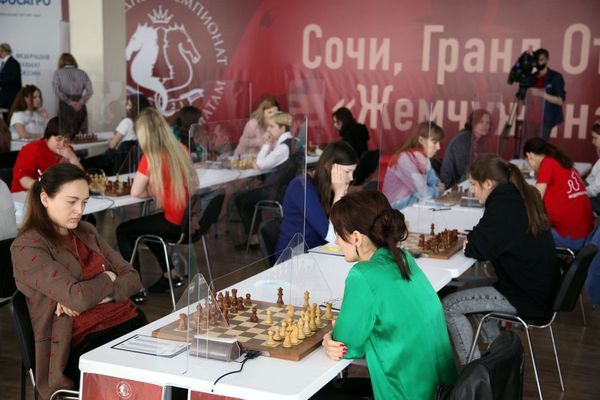
Lagno (Moscow Chess Team) – Ushenina (Ugra)
Ruy Lopez С67
1.e4 e5 2.Nf3 Nc6 3.Bb5 Nf6 4.0–0 Nxe4 5.Re1 Nd6 6.Nxe5 Be7 7.Bf1 Nxe5 8.Rxe5 0–0 9.d4 Ne8 10.d5 Bc5 11.Re1 d6
This line is considered harmless for Black, but Kateryna Lagno has something up her sleeve.
12.Nc3 Bf5 13.Ne4!?
The mainline is 13.Bd3, and the text seems to have never been played at the highest level.
13...Bxe4 14.Rxe4 f5 15.Re1 Qh4
It looks logical and energetic so far, and it probably explains why White refrained from 13.Ne4. However, knowing the course of the game one can propose a more reserved plan: 15...Nf6 16.h3 Ne4.
16.g3
.jpg)
16...Bxf2+
Well, Black gets two pawns, two checks and a menacing attacking position for the minor piece.
17.Kxf2 Qxh2+ 18.Kf3
Black enjoys strong initiative with a draw in the pocket after 18.Bg2 Nf6 19.Qf3 Ne4+ 20.Ke2 Rae8.
18...Nf6
18...f4! 19.gxf4 Nf6 20.Qe2 Qh5+ 21.Kg2 Ng4 seems the only way to go, but it you will never find it over the board.
19.Qd2!
The only move! Black wins after 19.Qe2 Qh5+ 20.Kg2 Ng4 21.Kg1 Rae8.
19...Qh5+ 20.Kg2
.jpg)
20...Ng4
20...f4! was essential for Black, getting counterplay after 21.gxf4 Rae8. The ex-world champion Anna Ushenina ditched the pawn next move, but it was already too late.
21.Kg1 f4 22.gxf4 g5 23.Qg2!
This move points out that the black king is now weak as well.
23...gxf4 24.Be2 f3 25.Bxf3 Rxf3 26.Re4!
The last finesse. 26.Qxf3? Qh2+ 27.Kf1 Rf8 was clearly underwhelming for White.
26...Qh2+ 27.Qxh2 Nxh2 28.Kxh2 Rf2+ 29.Kh3 Rxc2 30.Bh6 Kh8 31.Rg1 Black resigned.
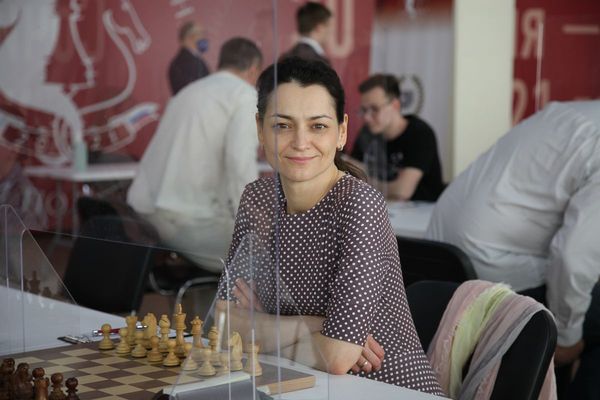
Kosteniuk (Moscow Chess Team) – Girya (Ugra)
.jpg)
24.Nd5
White managed to break through the center and seized the initiative in the open line of Ruy Lopez. Black lags behind in development and his position looks dangerous, but after 24...Ng6 25.Bg3 Rc8 26.Nxc7 Qe7 27.Qd3 Bc6 28.Nxa6 Qb7 she could have defended stubbornly. Olga Girya seems to have overlooked her opponent’s cute tactical resource.
24…Be6 25.Nxc7 Rc8
Counting on something like 26.Bg3 f6. But…
26.Rd8! Rxd8 27.Nxe8 Rxe8 28.Bg3 Rc8 29.Qe2 Nc6 30.Qxa6
A queen is a monster in an open position, while opposite-colored bishops promise a direct offensive against the king.
30…Nd4 31.Bd6 Nxb3 32.Bxb4 Re8 33.Bc3 f6
.jpg)
34.g4!? Bf7 35.h4 Nc5 36.Qc6 Ne6 37.Qf3 Nc7 38.Bd2 Rb8 39.b4 Nd5 40.Qd3 Nxb4?
It all comes down to a blunder on a time control move.
41.Qd6 Rc8 42.Bxb4 Rc4 43.f3 Black resigned.
Thanks to two white victories and two black draws ShSM scored a 3:1 victory.
The situation is similar in the men's Premier League as Mednyi Vsadnik crushes everyone and everything. That rare case when all or almost all of the team members were in good shape, and even luck sides with them.
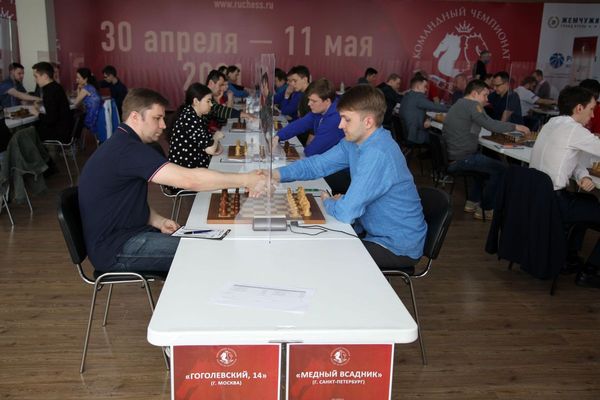
Vitiugov (Mednyi Vsadnik) – Motylev (Gogolevsky, 14)
.jpg)
The position can be offered as a test as to what opening has been played? It seems that the bishop opening 1.e4 e5 2.Bc4 is the last thing that comes to mind!
Black has decent counterplay after 24...f4!? because all White’s pieces are stuck on the queenside. However, Alexander Motylev rushed to bring into play his worst piece.
24...Nc7? 25.Qf4!
A fork threatening both the d6 and h6 pawns.
25…Kh7 26.Qxd6 Nb5 27.Qg3
An important nuance: Black is not in time to claim the exchange due to the checkmate.
27…Rf7 28.R3a2 Nc7 29.d6 Nb5 30.Be5, and Nikita Vitiugov went on to score victory on move 49.
Esipenko (Mednyi Vsadnik) – Kobalia (Gogolevsky, 14)
.jpg)
Black is up a pawn, but his pieces are bogged down on the queenside. A simple 23.Bh4 Rxf4 24.Rxf4 exf4 25.Bf2 looks very strong indeed, but Esipenko does not stop at sacrifices.
23.fxe5!? Rxf1+ 24.Rxf1 hxg5 25.e6 Qd8
More stubborn is 25...Qe8 26.Rf7 Nc6! 27.Qxc4 Bc8!, trying to give back the extra material but save the king. Now the White’s attack isself-rolling.
26.Qh5 Qe7 27.Rf7 Qc5+ 28.Kh1 Bxc3 29.Rf3!
.jpg)
29...Be1
29...Rf8 30.Rh3 is also bad. 29...Qe7 30.bxc3 Bc8 31.Rf7 Rb1+ 32.Bf1 Rxf1+ 33.Rxf1 Bxe6 34.dxe6 Qxe6 35.Qxg5 Qxe4+ 36.Qg2 Qe6 could have prolonged the fight.
30.Qf7+ Kh8 31.e7 Qd6
Or 31...Bc6 32.dxc6 Qxc6 33.Qf8+.
32.e8Q+ Black resigned.
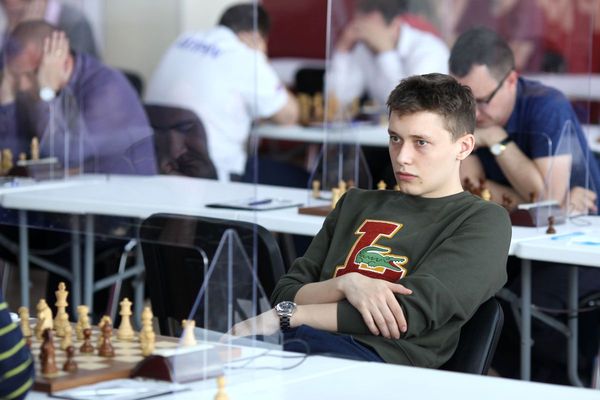
Two more striking episodes from the matchup of teams fighting for medals.
Najer (Moscow Chess Team) – Antipov (Wildberries Molodezhka)
Ruy Lopez С65
1.e4 e5 2.Nf3 Nc6 3.Bb5 Nf6 4.d3 Ne7
This original setup is unlikely enough for equality.
5.Bc4
Sidestepping the well-known trap: 5.Nxe5? c6 6.Bc4 Qa5+ 7.Nc3 Qxe5.
5...c6 6.Nc3 d6 7.d4
Evgeny Najer adheres to the classical laws: the opponent is behind in development - it is time to open up the game.
7…exd4 8.Qxd4 Ng6 9.e5
.jpg)
9...Qe7
9...dxe5 10.Bxf7+ or 9...Nxe5 10.Nxe5 dxe5 11.Bxf7+ Ke7 12.Qc4 are both bad for Black.
10.Bf4!?
White is trying to squeeze as much as possible from the position. After 10.Qxd6 Qxd6 11.exd6 Bxd6 12.Be3 the initiative is also with White due to better development, but it may prove not enough in the end.
10...Nxf4 11.Qxf4 d5
The only way to go: after 11...dxe5 12.Nxe5 Be6 13.0–0–0 Black is doomed.
12.0–0–0
In the style of the old masters! I dare suggest that Evgeny hardly took the cautious retreat 12.Bb3 into considerations.
12...Nh5 13.Qe3 Qc5
Black declines the piece sacrifice, although after 13...dxc4 14.Ne4 there would have arisen a position very rich in tactical resources.
.jpg)
After 14...Qe6 White has a pleasant choice between the simple 15.Qg5 Be7 16.Qxh5, restoring the material balance, and the more ambitious 15.Rhg1, intending g2-g4.
This said, after 14...Qb4!? there is no winning back the piece: 15.Qg5 Be7 16.Qxh5 c3! 17.Nxc3 Bg4, and the white queen is trapped!
Therefore, instead of 15.Qg5 stronger is 15.Nd4 c3 16.bxc3 Qa3+ 17.Kb1 Be7 18.Nd6+ with the most dangerous attack that still requires high precision of White.
14.Rd4!
Najer carries out the offensive with inspiration!
14...Be7?
This decisive error transposes the game into a technical phase. For better or worse Black should have gone for 14...dxc4 15.Rhd1 Be6 (15...Be7? fails to 16.Rd8+! Bxd8 17.Qxc5) 16.g4. After something like 16…Qa5 17.Ng5!? Bc5 18.Nce4!? Bxd4 19.Nd6+ Ke7 20.Qxd4 White enjoys a formidable offensive, confirmed by the engine’s evaluation. However, if you look away from the screen, Black still has an extra rook, no forced checkmate is in sight, and anything can happen over the board.
15.Bxd5! cxd5 16.g4 Bxg4 17.Rxg4 Qxe3+ 18.fxe3
So, the game has transposed into an endgame, and even with equal material, but this is where Black's achievements finish. He has a very poorly positioned knight on h5, and the d5-pawn is clearly a goner.
18…f5 19.Ra4 Rd8 20.Rd1 f4!?
20...a6 21.Nxd5 Kf7 22.Nxe7 Rxd1+ 23.Kxd1 Kxe7 24.Rb4 b5 25.a4 or even 25.c4 is entirely grim-looking.
Mikhail Antipov is a very inventive chess player, and even in a very bad positions he would finds an opportunity to muddy the waters.
21.exf4 Bc5 22.Nxd5 Rf8 23.Rc4
23.Rd3! is more precise to take the e3-square under control to stop any possible counterplay connected with Nxf4 and Be3+.
23...Nxf4 24.Rxc5 b6
24...Nxd5 is more stubborn, although after 25.Nd4 Ne3 26.Rd3 Black’s situation is not a holiday.
25.Rc6 Rxd5 26.Rxd5 Nxd5 27.Rc8+ Ke7 28.Rxf8 Kxf8
.jpg)
And White went on to convert her up a pawn edge in a knight ending rather confidently.
29.Kd2 Kf7 30.c4 Nc7 31.Ke3 h6 32.Nd4 g5 33.Ke4 Kg6 34.Nc6 g4 35.Nxa7 Kg5 36.Nb5 Ne6 37.b4 h5 38.Nd4 Nc7 39.a4 Kh4 40.b5 Kh3 41.a5 Black resigned.

Yuffa (Wildberries Molodezhka) – Popov (Moscow Chess Team)
.jpg)
25...Qxb4
Black has displayed accuracy in defending his cramped position and now offers his opponent to start mass trades. After something like 26.Qf3 Qe7 27.Bb6 Re8 28.Bxe6 Rxd3 29.Bxf7+ the draw is not far off, but Daniil Yuffa put everything at stake and plunged headlong into complications.
26.Qxe6
A spectacular blow, which happened to result in victory. Objectively speaking, however, this is not the best approach.
26...fxe6 27.Bxe6+ Kh8
It was high time to recall Steinitz's postulate that the king is capable of defending himself. After 27...Kg7! 28.Rxd7+ Rxd7 29.Rxd7+ Kf6 30.Bg8 Bd6 31.Bh6 Ke5! Black’s winning chances are excellent.
28.Bxd7 Bg7 29.Bxb5 Rxd3 30.Rxd3 Qxa5
We are going to see soon why the bishop is not to be touched.
31.Bxa6 Qa1+ 32.Kg2 Qxa6??
What a turn of events! Ivan Popov has rejected the Greek gift twice, and on the third time he probably miscalculated something. After 32 ... h5, the game should have ended in a draw.
.jpg)
33.Rd8+ Bf8 34.Bh6!
It's all about this intermediate move: the trap has slammed shut. 34…Qb7+ 35.Kg1 Since the king escapes checks easily, Black resigned.
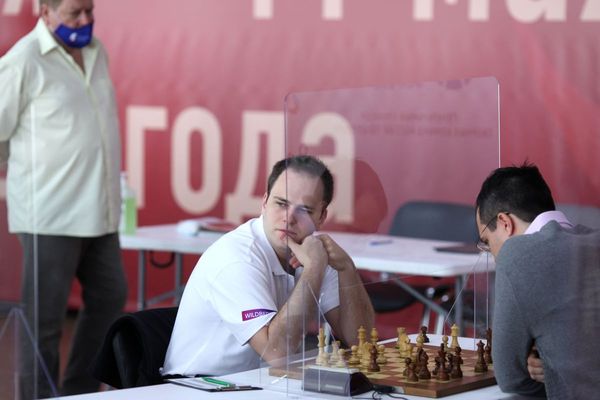
Pictures by Vladimir Barsky






















